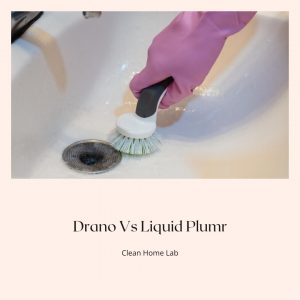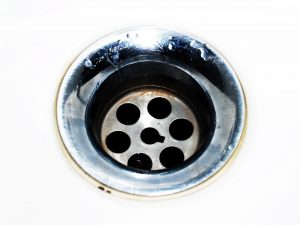Last Updated on March 4, 2023

Your house is connected with pipes that bring clean water into your faucets and equipment like dishwashers and dirty water out of your drains. You don’t care about drains while they’re operating well, but you notice them when they’re blocked.
Cleaning partially or completely blocked drains can be a difficult undertaking for any homeowner. The excellent thing is that there are a variety of clog-removing household plumbing devices available to eliminate any obstacles in your drain.
Liquid Plumr and Drano are two of the most popular drain cleaning products available at home repair stores and online.
Drano Overview
Drano began in the early 1920s as crystals. Bristol-Myers purchased the Drano firm in 1965 and held it until 1992 when it was transferred to S.C. Johnson.
Drano crystals are still readily available, but Drano gel is also present. The gel/liquid variant is the most popular, and it was created as a direct result of Clorox’s release of Liquid-Plumr. Other varieties of Drano exist as well. Except for PVC, most are safe for all pipes; however, one is particularly designed for toilets. Drano, like its competition, is user-friendly and speedy!
Liquid plumr Overview
Clorox Corporation manufactures Liquid-Plumr. It has been around for a long time and was formally purchased by Clorox in 1969.
It was simple to use as a liquid drain opener and cleaning. Furthermore, Liquid-Plumr is not harmful to copper pipes, septic systems, PVC, or plastic. Rubber pipe is the only material that is incompatible with Liquid-Plumr. It just takes around fifteen minutes to unclog and clean your sink.
How Drano And Liquid Plumber Works
Let’s see how drain cleaner works:
Drano
One of the major active chemicals in Drano is sodium hydroxide, often known as lye, which disintegrates organic waste. Unlike some other products, Drano has aluminum shards, which lead to a vigorous chemical reaction and heat.
Due to lye interacting with water, the result creates heat at near-boiling temperatures. Heat speeds up the deterioration process.
After lye and softened grease combine, soap is created, and hot water dissolves. In the end, it reacts with metal and produces hydrogen bubbles. These bubbles help the clogged particles to become less stuck. Drano is incredibly powerful because it triggers a series of chemical reactions.
Liquid plumr
Liquid Plumr, as per the product details, has a triple action formula that gives the following advantages:
- The ability to flow through standing water
- Unclogging complete clogs
- Pipe protection
- Getting Rid of Odors
- Using a hydrophobic barrier to protect pipes every month
Liquid Plumr comprises two active ingredients: sodium hydroxide, often known as lye, and sodium hypochlorite, also known as bleach. When you mix the drain cleaner with water, the bleach reacts with the lye and water. As a result, the cleaner is acidic and emits heat. The liquid moves through pipes, dissolving obstructions.
Unclogging a drain using Liquid Plumr takes around 15 minutes.
Ingredients
Drano
- Water: the formula’s liquid foundation.
- Amine Oxide: A cleaning product that removes blockages and debris scum from drains.
- Sodium Hydroxide: By altering the pH and stabilizing the product, it enhances the cleaning efficiency of the formula. It also promotes the dissolution of organic waste in drain obstructions.
- Capric acid: a cleaning chemical that is effective in removing grime and residues. As a result, the filth in the drain is loosening and can be flushed out.
- Sodium hypochlorite: the main component in laundry detergent. It aids in the removal of mold and mildew from drains. It also dissolves blockages.
- Sodium Silicate: An inhibitor of corrosion used on faucets and drains.
- Lauric Acid: An emulsifier that binds components together and keeps them from separating in the recipe.
- Polystyrene Polymer: A film former that sticks to the pipe’s walls and keeps dirt from sticking. It helps with debris cleanup and keeps soap scum from adhering to surfaces.
Liquid plumr
- Water: primary ingredient in the majority of cleaning products.
- Sodium chloride: a kind of rock salt that thickens and stabilizes formulations.
- CetylBetaine: This surfactant is used to clean, but it also thickens and stabilizes formulations.
- Sodium Xylene Sulfonate: This component helps to stabilize the other substances in the mix.
- Sodium hypochlorite: Stabilized by potassium iodide.
- Green pigment 7: Adds color and serves as a tracer.
- Sodium Hydroxide: This chemical is a pH adjuster that also eliminates fatty, greasy, and acidic soils.
- Sodium orthosilicate: Protects metal components in drains while also preventing dirt redeposit.
- Sodium hypochlorite: It kills bacteria and dissolves difficult blockages.
See our Review on Professor Amor Drain Cleaner and Green Gobbler Drain Cleaner.
Pros and cons of Drano and liquid plumber
Drano
Plus points
- Low-toxic.
- Less expensive.
- More suitable for slow-moving or partial obstructions.
- Excellent for tough clogs.
Drawbacks
- It cannot be used after initial treatment.
- Denser and takes a little longer time to work.
Liquid plumber
Plus points
- Quickly acting.
- This product is ideal for fully blocked drains.
- Thinner in texture.
- Can be used after initial treatment.
Drawbacks
- More harmful than Drano.
- A little more expensive.
FAQs
Can you put Drano and Liquid-Plumr through standing water?
The Drano Gel Max and Liquid-Plumr are both capable of cutting through standing water with ease.
Is it safe to add Drano and liquid-Plumr with other products?
It is not safe to mix chemicals with Drano or Liquid-Plumr. Liquid-Plumr can be used as a subsequent treatment as long as you follow the manufacturer’s instructions.
What should we do if our skin comes into contact with the liquid drain cleaner?
After applying either of these products, it is crucial to promptly cleanse the afflicted area with water. If symptoms continue, you should see a doctor.
Final verdict
In the fight between Drano and Liquid Plumr, both solutions do the same thing: they clean your pipes. If you must choose between the two, however, we advise Liquid Plumr. In spite of the fact that it is a little more expensive, it is faster and more effective at clearing clogged drains than Drano.


Leave a Reply